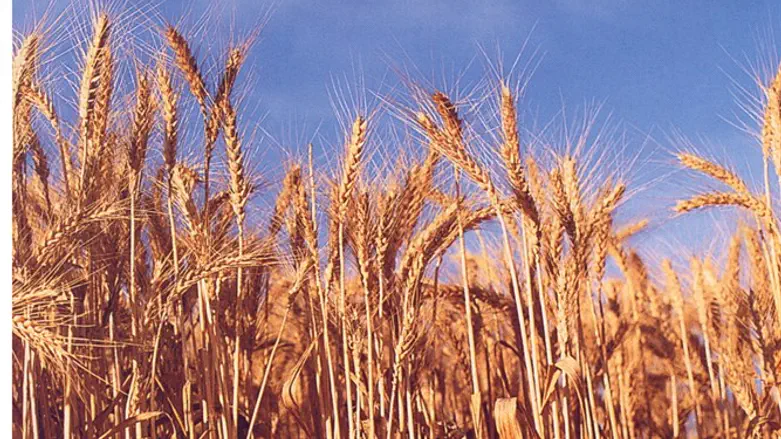
Tu B'Shevat, the "New Year of the Trees" (Chag La'ilanot) occurs on the 15th day of the Hebrew month of Shevat.
Tu BiShvat is one of four "New Years" mentioned in the Mishnah.
This year, Tu BiShvat begins at sundown on Sunday, January 20.
Tu Bishvat Has Arrived! טו בּשׁבט הגיע !!!
We honor this day when budding fruit enters a new year of life and the first bulbs of spring are beginning to bloom. The almond tree and other early bloomers awake from the winter slumber, sap begins dripping through the trees throughout Israel, and a new fruit-bearing cycle begins.
Our Rabbis in the Mishnah established that the fruit of the trees that blossomed before Tu Bishvat would be counted as produce of the previous year, and those which blossomed after Tu Bishvat would be considered the produce of the new tree year. This is important for the mitzvas of Orlah, tithing and Shmitta.
Fruits in Israel may not be eaten during the first three years of a tree's life when they are considered "Orlah." . In the fourth year, the fruits were still considered holy and intended only for use in the Temple (Leviticus 19:23-25). From the fifth year and onward, a portion of the fruits had to be apportioned as First Fruits (Bikurim) and Tithes (Maaser).
Maaser Sheni was a tithe that was eaten in Jerusalem, and Maaser Ani was given as a tithe to the poor. (Deut. 14: 22-29) These mitzvos were calculated by whether the fruit ripened before or after Tu Bishvat.
Tu Bishvat also allowed for the proper observance of Shmitta, when the fruit of the land in the seventh year cannot be eaten, used or sold. Knowing which year a given fruit belongs to helps ensure that we only eat fruits from the older trees that did not ripen in the Shmitta year.
THE SEVEN SPECIES
In honor of this beautiful holiday, it is traditional to eat fruits and grains that come from the land of Israel, particularly of the
"Shivat Minnim," the Seven Species:
(כי ה' אלוהיך מביאך אל ארץ טובה, ארץ נחלי מים, עיינות ותהומות יוצאים בבקעה ובהר, ארץ חיטה ושעורה וגפן ותאנה ורימון, ארץ זית שמן ודבש" ( דברים ח', ז-ח'
"For the LORD your God is bringing you into a good land—a land with brooks, streams, and deep springs gushing out into the valleys and hills; a land with wheat and barley, vines and fig trees, pomegranates, olive oil and honey." (Deut. 8:7-8)
1. Wheat - Chita - חיטה
2. Barley – Se’orah - שעורה
3. Grapes – Anavim - גפן
4. Figs – Te’enah - תאנה
5. Pomegranates – Rimmon - רימון
6. Olives - Zayit - זית
7. Honey - D'vash - דבש
In Israel, we plant trees to show our love for the preciousness of our land.
• It is customary to increase in the amount of fruits one eats on the 15th of Shvat, in order to praise G‑d who created all these species of fruits.
• In particular, one should include among the fruits one eats on this day the species of fruit which the land of Israel is praised for: grapes, olives, dates, figs and pomegranates.
• Some have the custom to make an effort and eat at least one fruit which one has not eaten that entire season, and would require the blessing of Shehecheyanu. When eating such a fruit, the Shehecheyanu should be said prior to reciting the blessing of "Haetz."
• Many also have a custom of eating carob on this day. There is yet another custom which many have and that is to eat the Etrog, either in the form of preserves or sugared slices.
• It was the custom of the famed Kabbalist Rabbi Isaac Luria ("Arizal") to eat 15 varieties of fruits on the 15th of Shevat.
• On this day Tachanun is omitted from the Shacharit and Mincha (morning and afternoon) prayers as well as from the Mincha prayer on the afternoon beforehand.
(https://www.chabad.org/library/article_cdo/aid/260798/jewish/Tu-BShevat-Customs.htm)
Tu Bishvat Seder
Some celebrate Tu Bishvat with a mystical Tu Bishvat Seder.
THE Tu Bishvat "SEDER" CELEBRATION
One of the most important authorities on Jewish Law, the Magen Avraham, writes in his notes to the Code of Law (131:16): "It is the custom on Tu Bishvat to eat many different kinds of fruit." The Kabbalistic celebration of Tu Bishvat that originated in Zefat, as recorded in Pri Etz Hadar, provides a listing of fruits to eat and passages to read arranged by an anonymous student of a student of Rabbi Yitzchak Luria [1534-1572], the greatest Kabbalist of Tsfat. It takes the form of a seder similar to the Passover seder. Certain fruits and wines are eaten and drunk in a particular order, accompanied by specific Torah readings.
For details on conducting a Tu Bishvat seder, go to:
http://ascentofsafed.com/cgi-bin/ascent.cgi?Name=tubshvat
OUR LOVE FOR THE LAND OF ISRAEL
Rabbi Eliyahu Kitov
The reason for the festive mood of this Rosh Hashanah of trees is that Tu Bishvat bespeaks the praise of the Land of Israel, for on this day the strength of the soil of Eretz Yisrael is renewed and it begins to yield its produce and demonstrate its inherent goodness and holiness. And it is with reference to the fruits of the trees and the produce of the soil that the Torah praises the Land of Israel, as the verse (Deut. 8:8) states: "A land of wheat and barley, of vines, figs and pomegranates, a land of olives and honey." The verse speaks of two types of grain and five types of fruit when describing the richness of Eretz Yisrael. The honey that the verse mentions refers to honey derived from dates. Thus, the day on which the soil of Eretz Yisrael receives renewed strength to give forth its bounty is a day of rejoicing for the people of Israel, who till the land, who love it and who yearn for it."
(https://www.chabad.org/library/article_cdo/aid/108989/jewish/Tu-BShevat-A-Weekday-Rosh-Hashanah.htm)
.
HAPPY Tu Bishvat!!!!
